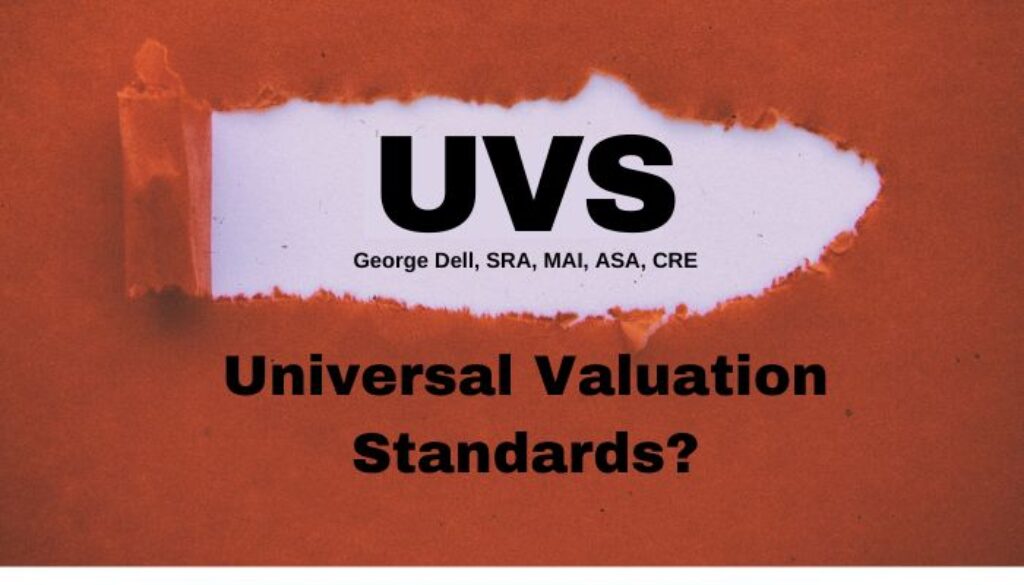What!? Universal Valuation Standards? Not possible!
This part 6 of a multipart look at issues in valuation standards. Editor’s Note: This is Standards, part 3.6 of George Dell’s series on How Do I Move to EBV? Links to the earlier posts are here.
The ‘possibility’ premise, however, is that all valuations follow the same logic and analysis. The only difference between AVMs, evaluations, BPOs, ‘value acceptances,’ “hybrids,” appraisals, and any other “method” – is simple: Who does it, and how thorough/detailed is each step.
The logic and process is identical: 1) Identify the problem; 2) Choose the data; 3) Apply the analysis; 4) Report results. (And add ‘testing,’ ‘review,’ or ‘audit.’)
We can compare each “product” on each of the above steps. To here keep within “blog bounds,” we will just compare AVMs to appraisals.
AVMs (the “automated” valuation model industry):
- The valuation problem: Assumptions are standard, including the lender assumption the property is a house, and the particular AVM is sufficient for the risk inherent in the loan. The user/lender makes the decision as to the scope-of-work appropriateness of the particular AVM for the particular property.
- The data is selected by an algorithm – designed by a software engineer/programmer. This can be as simple as a ‘circle search’ or with other limits – also by the programmer
- The analysis varies, with each AVM company having trade-secret predictive algorithms. These algorithms bring in facts, logic, and conclusions via programmer selection of the algorithm(s).
- Reporting includes a point value, and a proprietary ‘value range,’ confidence score, or fsd (forecast standard deviation).
AVMs currently have no standards, public or private. However, testing by independent testing companies is commonly found. Testing results often show differences in AVM results by geography, timing, property type, price range, and other factors.
Reproducibility is not possible. There is no transparency.
Appraisals are subject to numerous different standards, both public and private. For this discussion, we only look at USPAP (Uniform Standards of Professional Appraisal Practice). USPAP is published by a private organization, and enforced by US states and jurisdictions, for “federally-related transactions.”
- The valuation problem means the “scope-of-work” must be appropriate. A wrong subject depiction is the source of the largest errors in valuation. Appraisers are responsible for “the type and extent of research and analysis, property identification, inspection level, extent of data researched, and type/extent of analysis applied.”
- For the extent of data researched, (the ‘comparables’) appraisers decide the extent of data analyzed, the predictors (“elements of comparison”), and weight to be given each.
- The analysis for appraisers is adjustments to the hand-picked “comps.” Picking comps assures that there are more dependent variables than there are data points. This in turn ensures that adjustments are also subjectively estimated.
- Reporting is an “opinion.” Reliability is not estimated. However, the reconciliation of the sacred “three approaches” does try to explain why results differ within the analysis.
Reproducibility is not possible, because data selection is subjective. Adjustments are subjective. And the reconciliation is a story line, not numerically analytic.
Other valuation products, such as evaluations, BPOs, hybrids, ‘value-acceptance,’ drive-bys, third-party ‘professional’ inspector splits, and AMC “review,” ALL involve the same four-step solution. It is only a matter of who does each part, and how well is each part performed. Parts is parts.
UVS© Universal Valuation Standards simplify things. Different products can now be directly compared to each other. This means universal measures of reliability can be set, to supplement testing, and to provide a sharpened way to identify the best valuation/risk product prior to need, not after.
[Universal Valuation Standards© is a development of the CAA (Community of Asset Analysts) – dedicated to technologically current methods for valuation, risk, forecasting, auditability, fundamental value, and real-time revaluation].
